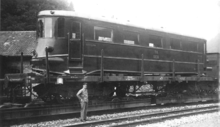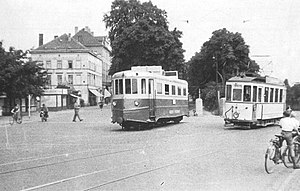SEG T7 and T8
| SEG T7 and T8 | |
|---|---|
|
MKB T2 next to a Minden tram railcar
|
|
| Numbering: |
SEG T7 and T8 MKB T2 |
| Number: | 2 |
| Manufacturer: | DWK Kiel |
| Year of construction (s): | 1923 |
| Retirement: | 1930 and 1956 |
| Type : | (1A) (A1) bm |
| Genre : | C4vT |
| Gauge : | 1000 mm ( meter gauge ) |
| Length over coupling: | 13,700 mm |
| Height: | 3,890 mm |
| Width: | 2,500 mm |
| Trunnion Distance: | 7,600 mm |
| Bogie axle base: | 1,450 mm |
| Smallest bef. Radius: | 75 m |
| Service mass: | empty: 17,800 kg |
| Top speed: | 40 km / h |
| Installed capacity: | originally 190 kW (260 PS) after conversion 81 kW (110 PS) |
| Wheel diameter: | 750 mm |
| Motor type: | Originally a benzene engine after conversion to a six-cylinder four-stroke diesel engine |
| Power transmission: | mechanically |
| Tank capacity: | 2 × 120 l |
| Brake: | Suction air brake type Körting |
| Seats: | 36 |
| Standing room: | 44 |
| Floor height: | 1,150 mm |
The railcars SEG T7 and T8 belonged to a series of the Deutsche Werke Kiel for the track width 1000 mm and were built in 1923.
The railcars corresponded to the vehicles that were colloquially known as shrews or submarines . They had a balancing lever coupling .
A whole series of narrow-gauge and standard-gauge vehicles were built by the DWK from these railcars . Their design features were:
- single-engine machinery
- All-steel car body with triangular car ends
- Bogie construction
- Roof cooling system
history
South German Railway Company

The first owner of the two railcars is said to have been the Finthen-Wackernheim transport company . The use of the vehicles was characterized by a lack of spare parts; so one railcar had to be parked as a spare part donor for the other because spare parts from Kiel were not available. Before they came into the possession of the Süddeutsche Eisenbahn-Gesellschaft in 1928 , a control shaft on one railcar and an axle on the other had to be changed to Bruch in 1927. They were used on the Zell-Todtnau Railway as SEG T7 and T8 . With them an attempt was made to make passenger traffic more economical and to separate it from goods traffic. Their use did not last long, because here the vehicles could not cope with the existing track conditions. They tended to skid and derail. When a railcar derailed between Mambach and Atzenbach in 1928 , it meant the end for the vehicles in the Wiesental. The T8 was sold to a customer in Latvia in 1930 , and the other railcar was also sold at the same time.
Mindener Kreisbahnen
The former SEG T7 was used as the MKB T2 on the narrow-gauge network of the Mindener Kreisbahnen . There it was equipped with a diesel engine with 110 hp and went back into regular operation in 1934. In the 1930s, mileage was given as 4000 kilometers per month. Around 1938 he got a general inspection, in which he received new wheel tires and the machine support frame was strengthened because it had proven to be too weak for the diesel engine.
With the beginning of the war, the mileage decreased noticeably, about 15,000 kilometers were specified in the year. In 1943 the annual reports no longer contain any entries, the railcar operation had come to a complete standstill due to the fuel shortage. After the Second World War , he served for a few years, primarily between Minden and Wegholm . At the end of the meter gauge time of the Mindener Kreisbahn, the railcar was decommissioned. The drive system was expanded and from 1956 it was used as a 565 trailer at the Emden – Pewsum – Greetsiel circuit . There it drove until it ceased operations and was scrapped in 1963.
Constructive features
The vehicles corresponded to the DWK type series IV built in 1923 in the pointed shape. Compared to the standard-gauge vehicles of this form, there were no changes except for the balancing lever coupling and the missing buffers.
The car body was welded and riveted from sheet steel. The framework consisted of steel beams, the roof of aluminum. Inside, an insulated cavity was clad with wood. With great stability, the weight of the car was comparatively low. The car was designed with the typical pointed end wall that gave it its nickname. On a photo of the vehicle, the shape of the window can be seen without the skylight. It is not clear whether it was covered by metal sheets or not at all.
The two-axle bogies were welded. The car body was placed on the bogies by means of spiral springs and could easily be lifted off after loosening a few connections. The axles of the wheel sets ran in ball bearings. The axle bushings were guided in axle forks and supported on spiral springs. When negotiating bends, the wheel sets shifted axially, which increased the cornering mobility. They were returned to their original position by means of return springs.
The interior was designed in the so-called wood class and designed with 2 + 1 seating facing each other. There were two fans in the roof for each seat compartment. The interior was completed by luggage racks and sun protection. The passenger compartment was separated from the entry areas by partition walls, in which the driver had his standing workplace. The car was originally heated by the engine cooling water.
The machine system initially consisted of a benzene engine from DWK and a mechanical gearbox from the same manufacturer. The engine had two igniters with spark plugs . Four-cylinder engines had one carburetor , six-cylinder engines two. The engine was started electrically, to be on the safe side there was still a possibility of starting with a hand crank on the side. The clutch was operated by a foot pedal, the gearbox had four gears for forward and reverse. The engine room was closed at the bottom so that dust and soiling was avoided. The entire machine system could be removed from below for maintenance work. The fuel consumption was stated in the catalog as 40 l / 100 km of driving distance.
This machine system was replaced at the Mindener Kreisbahnen by a diesel engine with an output of 110 hp, whereby the engine support frame was reinforced.
literature
- Rolf Löttgers: The railcars of the Deutsche Werke Kiel . Uhle & Kleimann, Lübbecke 1988, ISBN 3-922657-61-3 .
- Ludger Kenning, Michael Kopfmann: Narrow gauge railway Zell-Todtnau . Verlag Kenning, Nordhorn 2003, ISBN 3-933613-49-3 , p. 58-59 .
- Ingrid and Werner Schütte: The Mindener Kreisbahnen . Uhle and Kleimann, Lübbecke 1990, ISBN 3-922657-77-X .
- Gerd Wolff / Hans-Dieter Menges: German small and private railways Volume 2: Baden . EK-Verlag, Freiburg 1992, ISBN 3-88255-653-6 .
Web links
- Data sheet about the Zell-Todtnauer Bahn with mention of the T7 and T8
- Data sheet about the Minden circular path with mention of the T2
Individual evidence
- ↑ Rolf Löttgers: The narrow-gauge railway time in color . Franckhsche Verlagsbuchhandlung, Stuttgart 1983, p. 19 .
- ↑ Rolf Löttgers: The railcars of Deutsche Werke Kiel . Uhle and Kleimann, Lübbecke 1988, p. 3 .
- ↑ a b data sheet of the Zell-Todtnauer Bahn with mention of the T7 and T8
- ↑ Rolf Löttgers: The railcars of Deutsche Werke Kiel . Uhle & Kleimann, Lübbecke 1988, ISBN 3-922657-61-3 , p. 113 .
- ^ A b Ludger Kenning, Michael Kopfmann: Narrow-gauge railway Zell-Todtnau . Verlag Kenning, Nordhorn 2003, ISBN 3-933613-49-3 , p. 58-59 .
- ↑ Wolff / Menges: German small and private railways, Volume 2: Baden . EK-Verlag, Freiburg 1992, ISBN 3-88255-653-6 , p. 263 .
- ↑ a b c Rolf Löttgers: The railcars of the Deutsche Werke Kiel . Uhle and Kleimann, Lübbecke 1988, p. 115 .
- ↑ a b Rolf Löttgers: The railcars of Deutsche Werke Kiel . Uhle and Kleimann, Lübbecke 1988, p. 116 .
- ↑ a b data sheet of the Mindener Kreisbahn with mention of the MKB T2
- ↑ Rolf Löttgers: The railcars of Deutsche Werke Kiel . Uhle and Kleimann, Lübbecke 1988, p. 27 .
- ↑ a b Rolf Löttgers: The railcars of Deutsche Werke Kiel . Uhle and Kleimann, Lübbecke 1988, p. 45 .
- ↑ Rolf Löttgers: The railcars of Deutsche Werke Kiel . Uhle and Kleimann, Lübbecke 1988, p. 46 .
